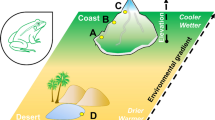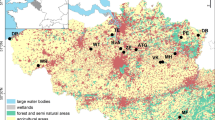Abstract
A basic premise of conservation geneticists is that low levels of genetic variation are associated with fitness costs in terms of reduced survival and fecundity. These fitness costs may frequently vary with environmental factors and should increase under more stressful conditions. However, there is no consensus on how fitness costs associated with low genetic variation change under natural conditions in relation to the stressfulness of the environment. On the Swedish west coast, natterjack toad Bufo calamita populations show a strong population genetic structure and large variation in the amount of within-population genetic variation. We experimentally examined the survival of natterjack larvae from six populations with different genetic variation in three thermal environments corresponding to (a) the mean temperature of natural ponds (stable, laboratory), (b) a high temperature environment occurring in desiccating ponds (stable, laboratory) and (c) an outdoor treatment mimicking the natural, variable thermal conditions (fluctuating, semi-natural). We found that larvae in the outdoor treatment had poorer survival than larvae in the stable environments suggesting that the outdoor treatment was more stressful. Overall, populations with higher genetic variation had higher larval survival. However, a significant interaction between treatments and genetic variation indicated that fitness costs associated with low genetic variation were less severe in the outdoor treatment. Thus, we found no support for the hypothesis that fitness costs associated with low genetic variation increase under more stressful conditions. Our results suggest that natural thermal stress may mask fitness losses associated with low genetic variation in these populations.



Similar content being viewed by others
References
Allendorf FW, Luikart G (2007) Conservation and the genetics of populations. Blackwell Publishing, Oxford, England
Altwegg R, Reyer HU (2003) Patterns of natural selection on size at metamorphosis in water frogs. Evolution 57:872–882
Andrén C, Nilson G (1985) Habitat and other environmental characteristics of the natterjack toad (Bufo calamita Laur) in Sweden. Brit J Herp 6:419–424
APHA (1985) Standard methods for the examination of water and wastewater, 16th edn. American Public Health Association, Washington, DC
Armbruster P, Reed DH (2005) Inbreeding depression in benign and stressful environments. Heredity 95:235–242
Baayen RH, Davidson DJ, Bates D (2008) Mixed-effects modelling with crossed random effects for subjects and items. J Mem Lang 4:390–412
Ballou JD (1997) Ancestral inbreeding only minimally affects inbreeding depression in mammalian populations. J Hered 88:169–178
Balloux F, Amos W, Coulson T (2004) Does heterozygosity estimate inbreeding in real populations? Mol Ecol 13:3021–3031
Bates D, Sarkar D (2006) lme4: Linear mixed-effects models using S4 classes. R Foundation for Statistical Computing, Vienna, Austria. ISBN 3-900051-07-0. http://www.R-project.org
Beebee TJC (1983) The natterjack toad. Oxford University Press, Oxford, England
Berven KA (1990) Factors affecting population fluctuations in larval and adult stages of the wood frog (Rana sylvatica). Ecology 71:1599–1608
Blaustein AR, Romansic JM, Kiesecker JM et al (2003) Ultraviolet radiation, toxic chemicals and amphibian population declines. Diver Distrib 9:123–140
Canty A (2006) boot: Bootstrap R (S-Plus) Functions. R Foundation for Statistical Computing, Vienna, Austria. ISBN 3-900051-07-0. http://www.R-project.org
Chen XF (1993) Comparison of inbreeding and outbreeding in hermaphroditic Arianta arbustorum (L). Heredity 71:456–461
Crawley MJ (2007) The R book. Wiley, Chichester, England
Crnokrak P, Barrett SCH (2002) Purging the genetic load: a review of the experimental evidence. Evolution 56:2347–2358
David P (1998) Heterozygosity-fitness correlations: new perspectives on old problems. Heredity 80:531–537
Falconer D, Mackay T (1996) Introduction to quantitative genetics, 4th edn. Longman, Essex
Ficetola GF, Garner TWJ, De Bernardi F (2007) Genetic diversity, but not hatching success, is jointly affected by postglacial colonization and isolation in the threatened frog, Rana latastei. Mol Ecol 16:1787–1797
Frankham R (2005) Genetics and extinction. Biol Cons 126:131–140
Frankham R, Ballou JD, Briscoe DA (2002) Introduction to conservation genetics. Cambrige University Press, New York
Gärdenfors U (2005) Rödlistade arter i Sverige. SLU Publikationsservice, Uppsala, Sweden
Gillespie JH (1998) Population genetics, a concise guide. The John Hopkins University Press, London
Gosner KL (1960) A simplified table for staging anuran embryos and larvae with notes on identification. Herpetologica 16:183–190
Hitchings SP, Beebee TJC (1998) Loss of genetic diversity and fitness in common toad (Bufo bufo) populations isolated by inimical habitat. J Evol Biol 11:269–283
Hutchison DW, Templeton AR (1999) Correlation of pairwise genetic and geographic distance measures: inferring the relative influences of gene flow and drift on the distribution of genetic variability. Evolution 53:1898–1914
Johansson M, Primmer CR, Merilä J (2007) Does habitat fragmentation reduce fitness and adaptability? A case study of the common frog (Rana temporaria). Mol Ecol 13:2693–2700
Kaeuffer R, Coltman DW, Chapuis JL et al (2007) Unexpected heterozygosity in an island mouflon population founded by a single pair of individuals. Proc R Soc Lond B 274:527–533
Keller LF, Waller DM (2002) Inbreeding effects in wild populations. Trends Ecol Evol 17:230–241
Kristensen TN, Sorensen P, Pedersen KS et al (2006) Inbreeding by environmental interactions affect gene expression in Drosophila melanogaster. Genetics 173:1329–1336
Langhelle A, Lindell MJ, Nyström P (1999) Effects of ultraviolet radiation on amphibian embryonic and larval development. J Herpetol 33:449–456
Liao W, Reed DH (2009) Inbreeding-environment interactions increase extinction risk. Anim Conserv 12:54–61
Niehaus AC, Wilson RS, Franklin CE (2006) Short- and long-term consequences of thermal variation in the larval environment of anurans. J Anim Ecol 75:686–692
Oromi N, Marquis O, Miaud C et al (2008) Influence of ambient ultraviolet radiation on Bufo calamita egg development in a semiarid zone (Catalonia, Spain). J Environ Biol 29:135–137
Peakall R, Smouse PE (2006) GENALEX 6: genetic analysis in Excel, population genetic software for teaching and research. Mol Ecol Notes 6:288–295
Pemberton J (2004) Measuring inbreeding depression in the wild: the old ways are the best. Trends Ecol Evol 19:613–615
Plummer M, Best N, Cowles K et al. (2006) coda: output analysis and diagnostics for MCMC. R Foundation for Statistical Computing, Vienna, Austria. ISBN 3-900051-07-0. http://www.R-project.org
Pray LA, Schwartz JM, Goodnight CJ et al (1994) Environmental dependency of inbreeding depression—implications for conservation biology. Conserv Biol 8:562–568
Rogell B (2009). Genetic variation and local adaptation in peripheral populations of toads. PhD thesis, Uppsala University
Rogell B, Hofman M, Eklund M et al (2009) The interaction of multiple environmental stressors affect adaptation to a novel habitat in the natterjack toad Bufo calamita. J Evol Biol 22:2267–2277
Rogell B, Thörngren H, Palm S et al. (2010) Genetic structure in peripheral populations of the natterjack toad, Bufo calamita, as revealed by AFLP. Conserv Genet 11:173–181
Rowe G, Beebee TJC (2003) Population on the verge of a mutational meltdown? Fitness costs of genetic load for an amphibian in the wild. Evolution 1:177–181
Rowe G, Beebee TJC (2005) Intraspecific competition disadvantages inbred natterjack toad (Bufo calamita) genotypes over outbred ones in a shared pond environment. J Anim Ecol 1:71–76
Scott DE (1994) The effect of larval density on adult demographic traits in Ambystoma opacum. Ecology 75:1383–1396
Swindell WR, Bouzat JL (2006) Selection and inbreeding depression: effects of inbreeding rate and inbreeding environment. Evolution 60:1014–1022
R Development Core Team (2006) R: a language and environment for statistical computing. R Foundation for Statistical Computing, Vienna, Austria. ISBN 3-900051-07-0. http://www.R-project.org
Waller DM, Dole J, Bersch AJ (2008) Effects of stress and phenotypic variation on inbreeding depression in Brassica rapa. Evolution 62:917–931
Weir BS, Cockerham CC (1984) Estimating F-statistics for the analysis of population-structure. Evolution 38:1358–1370
Willi Y, Van Buskirk J, Schmid B et al (2007) Genetic isolation of fragmented populations is exacerbated by drift and selection. J Evol Biol 20:534–542
Acknowledgements
We thank Per Westerfelt, Hampus Ericsson and Manuel Freibughaus for help in the field and in the laboratory. Mårten Hjernquist, Alex Richter-Boix, Torsten Nygaard Kristensen, Alexei Maklakov and Gustaf Granath commented on earlier versions of this manuscript. This study was supported by the Swedish Research Council Formas.
Author information
Authors and Affiliations
Corresponding author
Rights and permissions
About this article
Cite this article
Rogell, B., Thörngren, H., Laurila, A. et al. Fitness costs associated with low genetic variation are reduced in a harsher environment in amphibian island populations. Conserv Genet 11, 489–496 (2010). https://doi.org/10.1007/s10592-009-0039-2
Received:
Accepted:
Published:
Issue Date:
DOI: https://doi.org/10.1007/s10592-009-0039-2




